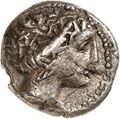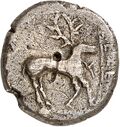NM·6.2: Difference between revisions
No edit summary |
No edit summary |
||
| Line 14: | Line 14: | ||
|site=unknown | |site=unknown | ||
|reading=seχeθu!ṣẹχ̣ẹθ̣ụ | |reading=seχeθu!ṣẹχ̣ẹθ̣ụ | ||
|reading_lepontic={{c|S||d}}{{c|E|E8|d}}{{c| | |reading_lepontic={{c|S||d}}{{c|E|E8|d}}{{c|Ψ|Ψ4|d}}{{c|E|E8|d}}{{c|Θ|Θ2|d}}{{c|U|U11}} | ||
|position=back, right-hand side | |position=back, right-hand side | ||
|orientation=90 | |orientation=90 | ||
Revision as of 19:57, 7 March 2024
| Coin | |
|---|---|
Coin type | |
| Coin type: | didrachm (Lejeune A6, Arslan IV) |
| Description: | obverse: right-facing female head, reverse: right-facing stag and legend |
| Material (main component): | silver |
| Average diameter: | 19.6 mm1.96 cm <br />0.772 in <br /> |
| Average thickness: | unknown |
| Average weight: | 7.4 g0.0074 kg <br />0.0163 lb <br /> |
| Workmanship: | cast |
|
| |
| Archaeological culture: | Golasecca III A |
| Date: | first half of 4th century BC |
| Date derived from: | typology |
|
| |
| Number of known pieces: | 2 |
| Area of circulation: | Padanian region |
| Mint / Main site: | unknown |
| Coordinates (approx.): | none |
Coin legend | |
| Idealised transliteration: | ṣẹχ̣ẹθ̣ụ |
| Idealised original script: | |
| Position: | back, right-hand side |
| Orientation: | 90° |
| Direction of writing: | unknown |
| Script: | North Italic script |
| Letter height: | 2 mm0.2 cm <br />0.0787 in <br /> |
| Number of letters: | 6 |
| Number of words: | 1 |
| Number of lines: | 1 |
| Inscription type: | minting authority |
| Language: | Celtic |
| Meaning: | 'Seχeθu' |
|
| |
| Alternative sigla: | none |
|
| |
| Sources: | Morandi 2004: 507 f. |
Images
Commentary
Two specimens of the coin type, commonly referred to as didramma del cervo, are known:
1. Chiesa 2000: 31: Switzerland (?), 7.2 g, 19.6 mm; Münzkabinett (Winterthur), inv. no. G 117 (scanned photo above): ]ẹχ̣ẹθ̣[
2. Chiesa 2000: 31: findplace unknown, 7.63 g, diam. 19.6 mm, thickness 4 mm; The Hunterian, University of Glasgow, GLAHM: 40386 (photos above): ṣẹχ̣ẹθ̣ụ
Images in Svoronos 1890: pl. XXXI.13 (photos of no. 1), MacDonald 1899–1905 II: pl. XLIII.9 (photos of no. 2), Chiesa 2000: 31 (photos = Gorini 2000: 42 [only no. 2]), Arslan 2000: 226 (photo of no. 1 = Arslan 2001b: 335 IV a = Geiser et al. 2012: 96, fig. 28), Morandi 2004: 510, fig. 5.1 (drawing of no. 2 legend).
No. 1 was published by Svoronos 1890: 131, no. 2; no. 2 is first mentioned in MacDonald 1899–1905 II: 200, no. 2.
The coin type belongs with group A of coin legends in the Lepontic alphabet, represented by legends on silver drachmae based on a Massaliote model with primary distribution in the Padan plain (see Numismatics). Svoronos considered his specimen to be Cretan, as did, initally, MacDonald, but the latter (vol. III, p. 748) noticed that the legend (with correct reading!) was the same as that on the dramma della civetta (NM·6.1) as depicted in Sambon 1903, and the coin consequently "Gaulish of Northern Italy". The comparison is reaffirmed by Chiesa 2000: 25–27. The coin type is the didrachm belonging to the dramma della civetta. The dating to the first half of the 4th century BC is based on that of the dramma della civetta. The motifs on the Glasgow specimen are more classically executed, indicating a higher date for this emission than for that to which the Swiss specimen belongs (MacDonald 1899–1905 II: 200, no. 2, Chiesa 2000: 27). While the head of Artemis on the obverse is the same motif as on the dramma della civetta and the Massaliote drachma, the stag motif on the reverse is modelled on emissions from Caulonia (Magna Greacia). See also Gorini 2000: 34 f., Geiser et al. 2012: 96.
As on the dramma della civetta, the legend is situated on the right side of the reverse, applied horizontally, with the top of the letters pointing inward, and separated from the image by a vertical line. Almost the full legend in the same execution as on the better-preserved dramme della civetta is legible on the Glasgow specimen, with only the lower ends of the letters and the lower bar of upsilon missing. The legend is dextroverse running upward as on the dramma della civetta, but upsilon is turned the other way. On the Winterthur specimen, whose outer rim is more damaged, only the upper parts of the middle letters – the two epsilons, chi and part of theta – are preserved. On this later emission, the legend is sinistroverse running downward.
seχeθu is an on-stem personal name, probably naming the authority (chief? magistrate?) under whose rule the coin was struck. On the orthography and analysis see NM·6.1.
Bibliography
| Arslan 2000 | Ermanno A. Arslan, "La monetazione con legende leponzie e la monetazione preromana dell'area leponzia e insubre", in: Raffaele C. De Marinis, Simonetta Biaggio Simona (eds), I leponti tra mito e realtà. Raccolta di saggi in occasione della mostra Locarno, Castello Visconteo - Casorella, 20 maggio - 3 dicembre 2000, Verbania: Armando Dadò Editore 2000, 223–233. |
|---|---|
| Arslan 2001b | Ermanno A. Arslan, "Circolazione ed emissione della moneta nella Lombardia protostorica: status quaestionis", in: Various authors, La protostoria in Lombardia. Atti del 3o convegno archeologico regionale, Como – Villa Olmo 22–23–24 ottobre 1999, Como: 2001, 325–335. |
| Chiesa 2000 | F. Chiesa, "Le Monete della Prima Fase delle Emissioni Argentee con Legende Leponzie", in: Ermanno Arslan, Riccardo Carazzetti (eds), I Leponti e la moneta. Atti della Giornata di studio "I Leponti e la moneta" in occasione del X anniversario di fondazione del Circolo Numismatico Ticinese (1986–1996) Locarno, 16 novembre 1996 in onore di Franco Chiesa, Locarno: Circolo Numismatico Ticinese 2000, 23-32. |



